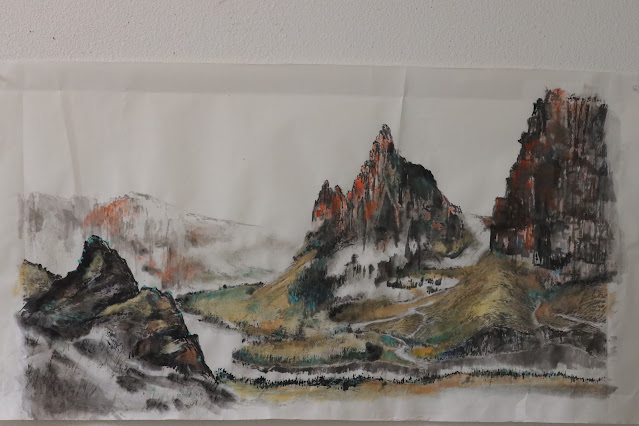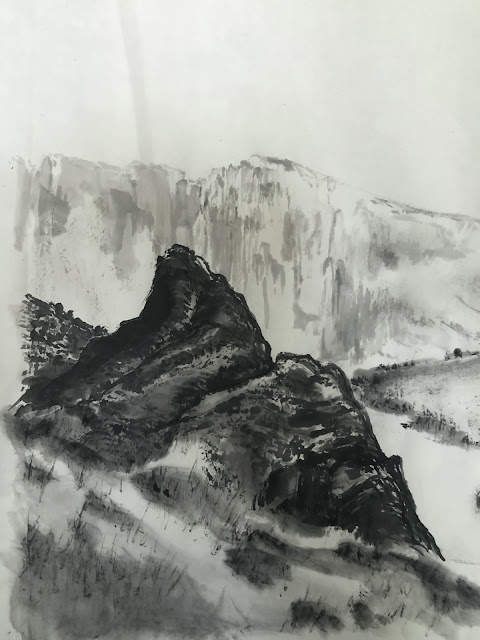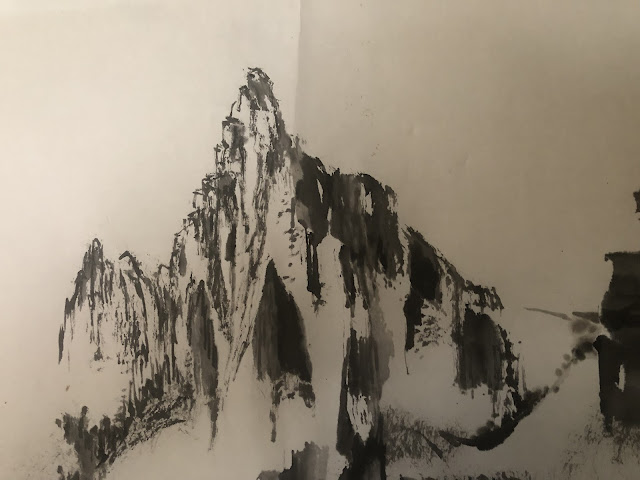At the onset of the painting I laid out my objectives for this painting, and one of them was to be able to highlight each of the 4 landmarks of the Columbia River Gorge by incorporating them into my fictitious staging of a real historical Chinese naval battle, the Battle of Chibi. The landmarks are of course the Vista House on top of Crown Point, the Multnomah Falls, the Rowena Loops and the Stonehenge replica. I also wanted these 4 subplots to be able to stand on their own rights as a painting by themselves.
Now that the painting is finished, let us delve into these 4 elements.
The Vista House at Crown Point:
The red cliff face is adorned with loads of vertical hemp chuen brushstrokes to give the surface texture. These brushstrokes stand out nicely against the staining done from the back of the paper. The Vista House itself is too big when compared with the real structure. Visually speaking, the building should be perhaps on the scale of 1/50th the height of the cliff. So my Vista House is at least 10 folds too big. I suppose my zeal of wanting to emphasize the structure got the better of me! To my defense, this is a fictitious painting, so accuracy is not a prerequisite and anything goes.
The Multnomah Falls:
I like to draw the viewer's attention to the
hemp chuen brushstrokes in the light areas of the hills. The red color reveals beautifully against the light staining from the back of the paper. Together with washings of different ink tones, a rich texture is achieved without rendering a messy appearance of unbridled brushstrokes. In other words, a clean look.
The Rowena Loops:
Realistically speaking the winding roads should be more on a level plane than hanging off the sides of the cliffs. But this is much more dramatic! Right? I really enjoy the dreamy background of distant ranges as depicted by the very loose and relaxed brushstrokes.
The Stonehenge:
I am particularly fond of the classical rendering of the shrubs and trees. I also love the very simple coloring scheme. It exudes an air of a Chinese painting for sure.
I am going to be mounting my painting on canvas. I already have my canvas primed with gesso and ready to go.
The painting is laid face up on a flat surface and wetted down to relax the fibers.
During the course of doing this painting, I inadvertently ripped a hole in my paper.
I used to freak out about such mishaps. Now I don't fret over it anymore, because these tears will be almost imperceptible after mounting. The glue will mend the tears as long as the flaps are kept intact.
The wetted paper is allowed to dry to a "moist" state such that there is no dripping water and the paper is soft and pliable without getting too fragile due to the additional weight of the moisture content. Now it can be rolled up and be ready for the next step, which to affix it to my canvas.
Starch is applied to my canvas and the rolled up painting is aligned and unfurled onto the canvas and pressed down for good adhesion. The whole assembly is allowed to dry.
Painting on canvas after drying:

With frame:
EPILOGUE
My inspiration of the painting came from bantering with my overseas friends about using Chinese literature in songs etc. and I was motivated to put in my two cents with my painting. As I have stated, my painting borrows from the landmarks of the Columbia River Gorge.
I have done a painting of Columbia River Gorge before, a strictly scenic rendition. I am putting these two paintings up for comparison.
I feel that my Red Cliffs Nostalgia piece is infinitely more poetic. I believe the fact that I have the words of Su Dongpo to teach me makes a huge difference in my interpretation of the otherwise identical river gorge, albeit with a few landmarks rearranged.
My new painting wears a understated elegance; as if it was cloaked in a Sarong of silence, allowing the words of Su Dongpo to enunciate:
"大江東去浪淘盡 千古風流人物
江山如畫 一時多少豪傑
故國神遊 多情應笑我
人生如夢 一樽還酹江月"
"The incessant waves urge the river eastward, taking with them all the accomplished people. Such picturesque landscapes, how much history have they witnessed. Perhaps I am being too sentimental, reminiscing the days gone by. Life is but a dream. allow me to scatter my wine, ode to the river, and to the moon."
















































